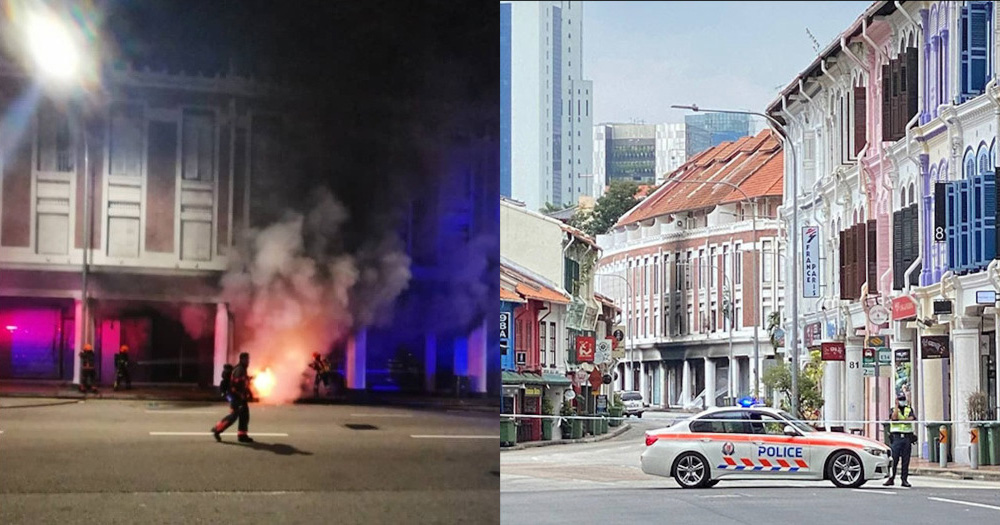Follow us on Telegram for the latest updates: https://t.me/mothershipsg
The fire that occurred following the car crash along Tanjong Pagar Road on Feb. 13, 2021, was sparked by the vehicle's ruptured fuel tank and the deformation of its exhaust system, according to Major Huang WeiKang from the Singapore Civil Defence Force (SCDF).
The senior fire investigator was testifying at the first day of the coroner's inquiry into the fatal accident which took the lives of the driver Jonathan Long Junwei, 29, and four other passengers — Eugene Yap Zheng Min, 29, Elvin Tan Yong Hao, 28, Teo Qi Xiang, 26, and Gary Wong Hong Chieh, 29.
Collision deformed exhaust system and ruptured fuel tank
According to Huang's report on the incident, the car's collision with the shophouse severely deformed the car's exhaust system, which caused it to come into contact with the vehicle's fuel tank.
In addition, the collision ruptured the car's fuel tank, which caused petrol to spill out and come into contact with the hot exhaust system.
This could have been how the fire started, Huang said.
The investigator added that it is unlikely the fire could have started at the engine given that its components still are relatively distinguishable, despite some melting.
As for its spread, Huang said combustible plastics in the car could have ignited along with the petrol, which is how the fire rapidly spread.
The road surface also trapped petrol vapours that spilled from the tank, which contributed to the fire's spread in a matter of seconds.
The fire's temperature subsequently reached a temperature of 600 degrees Celsius.
When the first SCDF crew arrived at the scene, flames had already engulfed the rear and top sections of the vehicle. The passenger compartment was also ablaze and the fire was threatening to reach the engine compartment, Huang said.
Car had been travelling between 110km/h to 148km/h before collision
Prior to its collision, the car had been travelling at a speed between 110km/h to 148km/h, according to investigating officer Muhammad Firdaus bin Suleiman, who was called up to the stand before Huang.
Firdaus noted that the driver, Long, had 86 miligrams of ethanol per 100 mililitres of blood, just above the drink-driving limit of 80 miligrams of ethanaol per 100 mililitres of blood.
The other four passengers were also found to be drunk. The level of alcohol in their blood was found to be 119mg/100ml for Yap, 162mg/100ml for Teo, 128mg/100ml for Tan and 111mg/100ml for Wong.
The five men were still alive after the crash happened before the fire started, according to the autopsy report.
However, the car’s passenger side door was blocked by the shophouse’s roller-shutter, while the driver’s seat door could not be approached because of the intense heat.
All five men died afterwards due to severe burns and other injuries.
According to the Attorney-General's Chambers, the Coroners Act specifically prohibits the Coroner from framing a finding to determine any question of criminal liability.
Top collage left photo via Song Sen Wun/Facebook, right photo by Sulaiman Daud
If you like what you read, follow us on Facebook, Instagram, Twitter and Telegram to get the latest updates.
